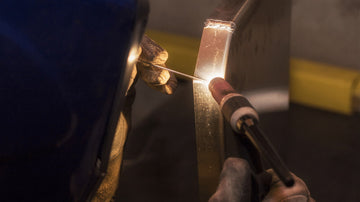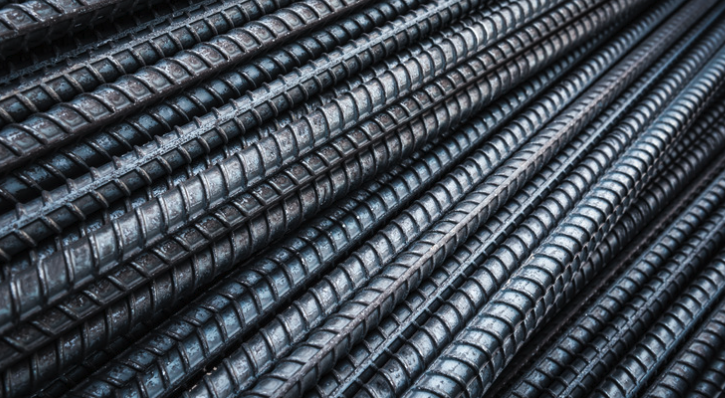
Welding aluminum to steel might seem tricky because these metals are very different. When you're welding aluminum and steel, remember they're pretty different. Aluminum melts at a lower temperature than steel, so it can get too soft fast when you're welding. Plus, aluminum can cool down quicker because it handles heat better, and that can lead to a weaker weld if you're not careful.
In this article, we explain how to join aluminum and steel, even though it's not easy. We'll talk about what makes these metals hard to weld together and show you special ways to do it. You'll learn about the tools and tricks needed to make a good weld between aluminum and steel.
This guide is for anyone who wants to understand the challenge of mixing these two metals and how to overcome it. We'll make sure you get the basics, the steps involved, and how to make the weld strong and last a long time.
Join us as we break down the process and make welding aluminum to steel clearer and more doable.
Understanding Welding Dissimilar Metals: Aluminum to Steel
When you're welding dissimilar metals together, like aluminum and steel, you've got to think about a few things first. You need to pick the right kind of filler metal, and you've got to understand the metals you're working with.
Some metals don't mix well with just melting and fusing them together—that's when you use fusion welding. Since aluminum and steel have different features and don't react the same way to heat and stuff, they can be tricky to join.
But if you use the correct methods and tools, you can weld them together in a way that's strong and will last.
Characteristics of Aluminum

Aluminum is a lightweight metal that is highly resistant to corrosion. It is also a good conductor of heat and electricity, making it ideal for use in a wide range of applications, including automotive and aerospace industries. Some of the key characteristics of aluminum include:
- Low density
- High strength-to-weight ratio
- High thermal conductivity
- Low melting point
- Good formability
Characteristics of Steel

Steel is a strong and durable metal that is widely used in construction, manufacturing, and other industries. It is an alloy of iron and carbon, and may also contain other elements such as manganese, chromium, and nickel. Some of the key characteristics of steel include:
- High strength
- High hardness
- Good ductility
- High melting point
- Low thermal conductivity
For more welding steel tips please read our guides:
Key Differences Between Aluminum and Steel
When it comes to welding aluminum to steel, it's important to understand the key differences between the two materials. Here are some of the most important differences to keep in mind:
Melting Points
One of the most significant differences between aluminum and steel is their melting points. Aluminum has a melting point of 1,221 degrees Fahrenheit, while steel has a melting point of 2,500 degrees Fahrenheit. This means that when welding aluminum to steel, special care must be taken to ensure that the aluminum doesn't melt before the steel.
Thermal Conductivity
Another important difference between aluminum and steel is their thermal conductivity. Aluminum has a thermal conductivity that is approximately three times higher than that of steel. This means that when welding aluminum to steel, the aluminum will heat up much faster than the steel, which can create problems if not properly managed.
Reactivity
Finally, it's important to note that aluminum and steel have different reactivity properties. According to The Fabricator, aluminum has a natural oxide layer that can make it difficult to weld. This oxide layer must be removed before welding, which requires special techniques and equipment. Steel, on the other hand, does not have this oxide layer, so it is generally easier to weld.
Welding Aluminum to Steel: Is It Really Possible?

If you're doing welding work, you might have heard that you can't weld aluminum and steel together. But that's not true. You actually can join aluminum to steel, but you need to use special ways of doing it.
If you try to weld them the regular way, you'll get a weak, brittle spot where the metals mix. To prevent that, you've got to put a layer or a special kind of joint between the aluminum and the other metal. This keeps them from directly touching and messing up the weld.
Techniques for Welding Aluminum to Steel
There are several techniques for welding aluminum to steel, including:
- Adhesive bonding
- Mechanical fastening
- Brazing
- TIG welding
- Friction welding
1. Adhesive Bonding
Adhesive bonding is a method that uses a high-strength adhesive to bond aluminum to steel. This method is ideal when you need to join two dissimilar metals that cannot be welded together. Adhesive bonding is also useful when you need to create a seal between the two metals.
When using adhesive bonding, it is important to choose the right adhesive for the job. The adhesive must be able to withstand the stresses and strains that the joint will be subjected to.
2. Metal Fasteners
Metal fasteners, such as bolts, nuts, and screws, can also be used to join aluminum to steel. This method is simple and easy to use, and it does not require any special equipment.
When using metal fasteners, it is important to choose the right type of fastener for the job. The fastener must be able to withstand the stresses and strains that the joint will be subjected to.
3. Brazing
Brazing is another method that can be used to join aluminum to steel. Brazing uses a filler metal that has a lower melting point than the base metals. The filler metal is heated until it melts and flows into the joint, creating a strong bond.
Brazing is a good method to use when you need to join two dissimilar metals that cannot be welded together. However, it requires a high level of skill and precision to ensure that the joint is strong and durable.
4. TIG Welding
TIG welding can join aluminum to steel using a transition joint to prevent direct contact. This method avoids brittle welds by TIG welding aluminum to one side and steel to the other of a compatible insert. It's a precise, specialized technique for jobs needing both metals' properties.
Discover the top-selling ArcCaptain TIG Welder, perfect for beginners.
Friction Welding
Friction welding is a solid-state welding method that uses friction to create heat and weld the aluminum and steel. This technique involves rotating the aluminum and steel parts against each other until they reach a plastic state. The parts are then pressed together to create a solid bond.
Friction welding is a fast and efficient welding method that produces high-quality welds. It is also suitable for welding dissimilar metals and can be used to weld complex shapes. However, friction welding requires specialized equipment and is not suitable for welding thin materials.
Best Practices for Successful Welding of Aluminum to Steel
Welding aluminum to steel is a complex process that requires a thorough understanding of the properties of both metals, careful preparation, and the selection of appropriate welding techniques. Here are some best practices to help ensure successful welding of aluminum to steel:
Proper Preparation
Before welding, it is essential to clean both the aluminum and steel surfaces thoroughly to remove any dirt, oil, or other contaminants that could interfere with the weld. You can use a wire brush or sandpaper to remove any surface oxidation or corrosion. Additionally, it is essential to remove the aluminum oxide layer before welding, as it has a higher melting point than aluminum and can lead to porosity in the weld.
Proper Technique
To achieve a strong and durable weld, it is essential to use the correct welding technique. TIG welding is the preferred method for welding aluminum to steel because it provides a precise and controlled heat source. It is also essential to maintain proper temperature control during welding to prevent warping or distortion of the materials.
Use of Appropriate Filler Material
Choosing the right filler material is critical for achieving a strong and durable weld. The filler material should match the properties of both the aluminum and steel, and it should be compatible with the welding technique used. For example, using a filler material with a higher melting point than the aluminum can lead to cracking or porosity in the weld.
Post-Welding Practices
After welding, it is essential to inspect the weld for any defects or imperfections. You can use non-destructive testing techniques such as X-ray or ultrasonic testing to detect any cracks or voids in the weld. Additionally, it is essential to perform any necessary post-weld treatments, such as heat treatment or stress relief, to ensure the weld's quality and durability.
By following these best practices, you can enhance the quality and durability of welds between aluminum and steel. Proper preparation, technique, filler material, and post-welding practices are all critical factors that can impact the success of the welding process.
Choosing the Best Welding Machine for Welding Aluminum and Steel
Choosing the best welding machine for welding aluminum and steel requires a unit that offers versatility and control.
A machine with AC/DC TIG welding capabilities stands out as the optimal choice. TIG welding provides the precision needed for aluminum's sensitivity and the strength for steel's toughness.
For such tasks, a machine with pulse welding features and a high-frequency start is ideal. It allows for better control over heat input, minimizing warping in aluminum while penetrating steel effectively.
Additionally, look for machines with a robust amperage range to accommodate the varied thickness of these metals. Investing in a machine with these features ensures superior welds when joining aluminum and steel.
Conclusion
In conclusion, welding aluminum to steel, while challenging, is indeed achievable with the right knowledge and techniques. This journey through the complexities of welding these dissimilar metals highlights the importance of understanding their unique properties and the innovative methods that facilitate their union.
As experts in welding aluminum and steel, we've explored the specialized processes that ensure a durable and effective weld. Armed with this information, welders can confidently approach projects that require joining aluminum to steel, expanding their capabilities and pushing the boundaries of metal fabrication.
Remember, with patience and precision, welding aluminum to steel can lead to successful and robust outcomes.
Frequently Asked Questions
Can a MIG welder weld aluminum to steel?
No, a MIG welder cannot weld aluminum to steel. Aluminum and steel have different melting points and properties that require different welding techniques and equipment. MIG welding is suitable for welding steel, but not aluminum.
Do you weld aluminum with MIG or TIG?
Both MIG and TIG welding can be used for welding aluminum, but TIG welding is generally preferred for its precision and ability to produce high-quality welds. MIG welding can also be used, but it requires a special aluminum wire and a spool gun to feed the wire.
How do you attach aluminum to steel without welding?
There are several ways to attach aluminum to steel without welding, such as using mechanical fasteners like bolts, screws, or rivets, adhesive bonding, or brazing. However, welding is generally the best option for achieving a strong and reliable bond between aluminum and steel.
What is the best welder for aluminum?
The best welder for aluminum is a TIG welder, as it allows for precise control of the heat and the filler material, resulting in high-quality and visually appealing welds. However, TIG welding requires a higher level of skill and experience compared to other welding techniques.
Can aluminum be soldered to steel?
No, aluminum cannot be soldered to steel due to their different melting points and properties. Soldering requires the two materials to have similar melting points, which is not the case with aluminum and steel. Brazing or welding are better options for joining aluminum to steel.
